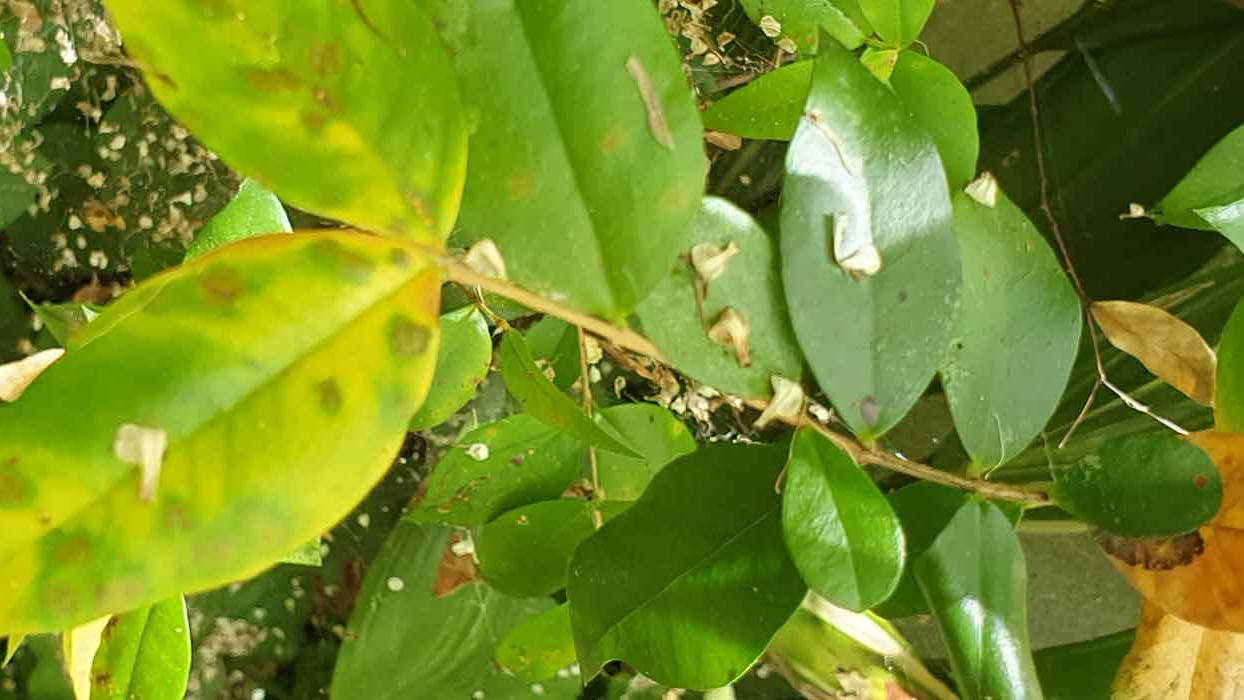A warm summer evening, a little bit of moisture, a shady spot in the garden – sounds like a recipe for powdery mildew! Powdery Mildew is a warm weather fungus that will flourish in shady spots with little air circulation and damp conditions. But few simple steps early in the season and a good watering routine will help reduce the risk of this disease attacking your patch or at least lessen the impact if it does.
What Does It Look Like?
Powdery Mildew is a white spotted soft fungus, of which there are numerous varieties. All are powdery in appearance, hence its name. When young, powdery mildew forms as tiny white circles on the leaf, it then reproduces rapidly covering the whole leaf in a white fur. The plant is usually worst affected lower down where it is more humid and sheltered. Mildew will form on the both the upper and undersides sides of leaves and the stem, so the whole plant can become infected. Powdery mildew usually appears in summer and autumn.
Older leaves are covered (especially on the upper surface) with the white powdery fur, young growth that is affected can look a little deformed. Leaves will yellow and die off as the fungus spores enter the leafs surface where the cells remove nutrients.
How does it live and grow?
Powdery mildew loves humid night’s when the temperature is about 15c, especially after a warm day, it just makes the fungus grow and spore. Light breeze’s assists the spores to spread. Particular spots at risk are the dry, warm and shady areas of the garden.
Watering the leaves of a plant in the afternoon increases the humidity at night therefore increasing the likelihood that the spores will spread.
Plants that are particularly susceptible to Powdery Mildew are pumpkin, cucumber, peas, roses, grapes, paw paws, strawberries & apples. There are various types of mildew that can affect different plants, sometimes at the same time. The treatment is pretty much the same for all of them.
Really wet weather, really low (or high) temperatures can reduce the likelihood of your plants suffering from Powdery mildew, though they are things you have no control over. There are some things you can do though to lessen the impact and spread of this furry fungus.
What To Do
- Always water your patch early in the day and ensure the water is delivered at the roots. Watering leaves late on a warm day is an open invitation for powdery mildew to move in.
- Pick up any fallen leaves and dispose of them in the bin, do not compost, most home compost heaps are not sufficiently hot enough to kill off spores.
- Removing the worst affected leaves from the plant may help slow the spread of the disease, plus it will allow for more air circulation.
- When planting out your patch leave plenty of room for each plant, overcrowding means poor air circulation and as we know – powdery mildew thrives where the air circulation is poor.
- Feed your patch with complete balanced organic fertilisers. High nitrogen fertilisers encourage leaf growth and too many leaves leads to – you guessed it – overcrowding and poor air circulation!
- Use a seaweed based plant tonic once a fortnight, it will not only help keep your plant strong, there is anecdotal evidence to suggest that it may help reduce fungal issues too.
- Try a milk spray; (about 1 parts full cream (preferably organic) milk to 10 parts water) and spray it on affected plants. It won’t stop it but it will slow it in it tracks and allow your plant to continue cropping for a few more weeks – always apply any spray treatment in the early morning, otherwise you may be encouraging more fungus.
The black and yellow Fungus Eating Ladybird (Illeis galbula) munches away at the fungus but NOT the leaf beneath! Yes, they’re a gardener’s friend, but definitely not a friend of powdery mildew.
Picture: Elaine Shallue (SGA)
Related Articles:
Low Impact Pest Management 101 Video
Sustainable Gardening 101 Video Series PART 3: Low Impact Pest Management Gardens are the natural habitat for all types of insects – the good, the…
Myrtle Rust is a Spreading Problem
Myrtle rust is a spreading problem in Australia. It is a fungus, Puccinia psidii, which affects plants in the family Myrtaceae. While there are…




